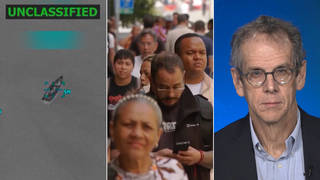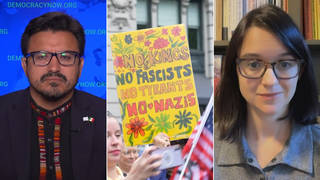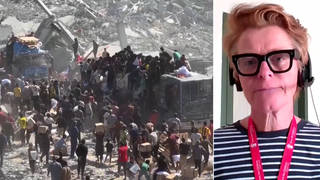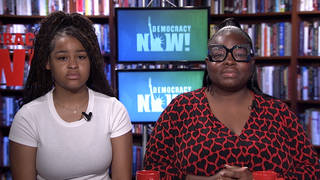
Guests
- Eriel Tchekwie Derangerexecutive director of Indigenous Climate Action and member of the Athabasca Chipewyan First Nation.
- Leila Salazar-Lopezexecutive director of Amazon Watch.
More than 190 countries agreed Monday on a plan to preserve 30% of the planet’s lands and waters by 2030 in order to protect biodiversity, which is rapidly declining due to human activity. The agreement was reached at a United Nations biodiversity conference in Montreal, Canada, known as COP15. The United States did not formally participate in negotiations because it is not a signatory to the U.N. Convention on Biological Diversity. The landmark agreement seeks to halt the Earth’s sixth major mass extinction event, and Indigenous communities will have an increased role in protecting wildlife as part of the deal. For more on the historic agreement, we speak with Leila Salazar-López of Amazon Watch and Eriel Tchekwie Deranger with Indigenous Climate Action.
Transcript
AMY GOODMAN: Today we begin our segments looking at what’s happening around the world when it comes to the climate crisis. More than 190 nations have agreed to protect at least 30% of the planet’s land and oceans for wildlife by 2030. The agreement was reached in Montreal at the U.N. biodiversity summit, known as COP15. The landmark agreement seeks to halt the Earth’s sixth major mass extinction event, currently underway due to human activity. As part of the deal, Indigenous communities will have an increased role in protecting wildlife.
Attendees at the summit included Helena Gualinga of the Sarayaku community in the Ecuadoran Amazon.
HELENA GUALINGA: We always talk about Indigenous people being 5% of the world’s population and protecting 80% of the world’s biodiversity. So, we are automatically, when we’re talking about biodiversity, we’re talking about Indigenous territories and Indigenous people.
AMY GOODMAN: Ayisha Siddiqa, from the tribal lands of Mochiwala in northern Pakistan, said Indigenous knowledge is key to preserving biodiversity.
AYISHA SIDDIQA: That knowledge comes from being part of that land. And you cannot just go into a place like the Amazon rainforest or the Himalayan mountains and take, like, samples of soil, take it back to your Petri dishes, and, over a few months, come up with a solution. It’s going to fail.
AMY GOODMAN: The United States did not participate in the formal drafting of the new agreement. That’s because the U.S. and the Vatican are the only two countries in the world which have not signed on to the U.N. Convention on Biological Diversity.
We’re joined now by two guests. Leila Salazar-López is executive director of Amazon Watch. And Eriel Deranger is executive director of Indigenous Climate Action. She’s a member of the Athabasca Chipewyan First Nation, joining us from Edmonton, Canada.
Eriel, let’s begin with you. Can you talk about the significance of this COP15? Happened after the U.N. climate summit in Sharm el-Sheikh. Many people headed right to Montreal for this key meeting. What was accomplished? And what wasn’t?
ERIEL DERANGER: So, I think that there were some really, really good accomplishments at the CBD COP15, including many, many, many references to Indigenous rights. I believe that there were over 20 references to Indigenous peoples, our rights, including free, prior and informed consent. And just as the earlier segments just stated, it’s absolutely impossible to create a biodiversity agreement without the inclusion of Indigenous rights, because 80% of remaining biodiversity is Indigenous lands and territories.
So, while we’re seeing massive progress to recognize the rights on paper, some of the biggest challenges and risks that have come out of this COP is the fact that there aren’t any real mechanisms with real teeth, similar to COP27, that actually protect our rights, our culture, and our ability to advance our rights to say yes and no to these types of agreements, that are pushing forward not just sort of “We’re going to protect biodiversity, we’re going to save the planet,” but they’re centering colonial economic ideals in the center. They’re still giving national and colonial states the power to determine what Indigenous rights look like when they’re implemented in these agreements, and how lands will be developed, undeveloped, protected, so on and so forth. There’s a lot of really flowery language, but there still lacks any real substantive ways for Indigenous peoples to be leaders in this movement like they claim that they are hoping to advance.
JUAN GONZÁLEZ: And, Eriel, could you talk about the significance of COP15 being co-hosted by China and Canada, two of the biggest polluters in the world and nations that still promote extractive industry and fossil fuels?
ERIEL DERANGER: I mean, both of these countries have a really big interest in being leaders, or at least the optics of being leaders, in advancing biodiversity safeguarding, because of that, because of the fact that they are massive leaders in creating emissions on the planet. My community, Athabasca Chipewyan First Nation, is downstream from one of the largest industrial projects on planet Earth, the Alberta tar sands, and we’re also within a UNESCO World Heritage Site that is being degraded, ongoing, ongoing, every single year, to the point that my community attended this COP to sort of highlight how this park continues to be degraded by industrial development. So, countries like Canada and China have a vested interest in appearing as though they are leading the way. In fact, there are reports that Canada is leading the way, that China is advancing technologies to help us meet these commitments. Yet the reality is, is they’re creating these optics and diversion tactics so that they can continue business as usual.
In Canada, where I come from, I can speak to this directly, where we are committing to “30×30,” millions and millions of dollars for biodiversity protection, Indigenous protection and conservation areas, yet we are not talking about ending the expansion of the Alberta tar sands. We are not talking about ending the destruction to biodiversity in other areas. We’re creating the optics of sacrifice zones, so we can choose which areas to save, which areas to diminish. And this results in human rights abuses, Indigenous rights abuses and the risking the planetary health for everyone.
JUAN GONZÁLEZ: I’d like to bring in Leila Salazar-López, executive director of Amazon Watch. Leila, from your perspective, what are some of the victories and what’s missing from this agreement? And how would some of the key aspects be implemented, from what you can tell?
LEILA SALAZAR-LÓPEZ: Yes. Good morning, Juan and Amy. So glad to be on the show with you all today.
And there are lots to reflect on about this COP15. And as Eriel already mentioned, this is something that we’re, on one side, looking at as, yes, it’s good that there’s an agreement. I think there’s a lot of comparisons to the Paris Climate Agreement. This agreement is to climate similar to how we were looking at, how we see the Paris Climate Agreement, to biodiversity, when we think of what’s really happening on our Mother Earth, when we think of the climate crisis, when we think of the mass extinction crisis that we’re facing as humanity on Mother Earth. We are in multiple crises, and I don’t need to name them all, but this is an advance, yes. And, as Eriel mentioned, it is — it mentions and acknowledges Indigenous peoples, and that is an advance, in comparison to what we would see in past years. And it is better than nothing. It is a framework. We’re looking at this as a framework for biodiversity and how we can move forward to avoid further extinction and further harm to biodiversity. Yet, there’s still a long way to go.
The aim, the aim, if we look at Target 3, the aim is 30×30. That means protecting 30% of land, water and resources by 2030. And that is what the majority — that is what the agreement calls for, one of the key elements of the agreement. However, you know, there are others that were calling for 50 by 2030. So, this is an advance, but there’s still a long way to go. There’s still a long way to go. When I think of the Amazon rainforest and the threats to the Amazon rainforest, the Amazon rainforest is already at a tipping point. It’s at a tipping point. And so, that’s the tipping point of ecological collapse in parts of the Amazon because of the deforestation and the degradation caused by many of the threats that Eriel was mentioning, including oil extraction, fossil fuel extraction, and mining. And so, Indigenous peoples, together with scientists and academics and activists and NGO organizations like Amazon Watch, we are calling for much beyond 30×30 or even 50×30. We are calling for 80 by 2025. And, yes, that is ambitious. And it’s very ambitious. But what we’re calling for is a permanent — a commitment to a permanent protection of the Amazon rainforest by 2025. And we didn’t get that, but we definitely advanced that call and the urgency of protecting the Amazon from global threats like industrial mining from countries like Canada.
AMY GOODMAN: Can you name some names, Leila? Talk about the corporations that have caused the most harm in the Amazon, and the private investors promoting open-pit mines, megadams and so forth, like Canada’s Belo Sun, plans for the massive open-pit gold mine in the Volta Grande region of the Brazilian Amazon, their stock taking a major hit while COP15 was taking place in Montreal. What do you attribute this to?
LEILA SALAZAR-LÓPEZ: Thanks for that question, Amy. Yes, many of you may remember the Belo Monte Dam fight. This is the biggest dam in the middle of the Amazon rainforest, on the Xingu River. In the midst of that fight 12 years ago, many of our allies, Indigenous peoples on the ground, the Brazilian civil society, said, you know, this dam — “Remember, this dam is not for energy, it’s for mining.” And we’re seeing that now. We’re seeing that Belo Sun, and from the very — from back then, Belo Sun was already eyeing the Xingu region to develop this massive gold mine.
So, Belo Sun is a Canadian mining company, and it has plans to build the largest open-pit gold mine, in the middle of the Brazilian Amazon, near the Belo Monte Dam, in the homelands of Indigenous peoples who are already threatened by this megadam, already threatened by cattle grazing, by agribusiness, by land grabbing. So, Belo Sun is a major culprit, and they are financed by the Royal Bank of Canada.
And so, one of the things that we did as an ally to Indigenous peoples and working to protect and defend the Amazon in solidarity with Indigenous peoples is we supported a delegation of Indigenous peoples from the Brazilian Amazon and other parts of the Amazon to call out Belo Sun in Canada. This was an opportunity, because, on the ground, they are not consulting Indigenous peoples. They are moving forward with their plans with the permission of the Brazilian government to build this largest — the largest open-pit gold mine. And so, we went there to call out Belo Sun. We released a report, the investment risks of Belo Sun, and held events and also held actions outside of banks, like the Royal Bank of Canada. And just last week, the stock price of this company tanked. And —
AMY GOODMAN: And —
LEILA SALAZAR-LÓPEZ: Go ahead.
AMY GOODMAN: We’re going to be wrapping, and I wanted to ask Eriel, as you talk about what’s happening in Canada, the lack of participation by the U.S. and the Vatican, what it means that it did not participate in the COP15 agreement, didn’t join the U.N. Convention on Biological Diversity. And do you think its lack of involvement may have been what led to it being less watered down than, for example, what happened in Paris, the well-known COP climate agreement?
ERIEL DERANGER: Absolutely. I think, without these key players, being the Vatican, you know, the origin of the colonial empire with the ideology of man’s dominion over nature, not being there, and the United States, which has a deep history of their conservation movement including the displacement, invisibilization and devaluing and the genocide of Indigenous peoples, not being there, absolutely is, A, not a surprise — let’s just get that out of the way — it’s not surprising that they didn’t see this as a priority. And, secondarily, this is why we led to some really strong language.
The concern, though, with the languages that came out of this is that it’s still up to the states. It still centers the economy, which is something that the United States and the Vatican are still going to applaud, and it still puts our communities, our lands and territories at risk for the ongoing colonial conservation movement that sees us as just someone to be consulted. We have consent throughout this document, but we all know that when it comes down to the states, it doesn’t matter what kind of language we have in these international agreements, if the states are still leading the way. We’re going to still see the destruction of the Amazon, the destruction of the boreal forest. UNESCO World Heritage has been in place for over a hundred years — it’s its anniversary — where my community lives, and my community is saying, “Stop giving the government this money. Give it to us. Let us protect the caribou. Let us protect the lands and the water.” For us, conservation and biodiversity management means landback. It means taking it out of hands like the Vatican and colonial empires that have created genocide for our communities.
AMY GOODMAN: Eriel Tchekwie Deranger of the Athabasca Chipewyan First Nation, speaking to us from Edmonton, Canada, she is executive director of Indigenous Climate Action, and Leila Salazar-López, executive director of Amazon Watch. Thanks so much for being with us. Of course, we’ll continue to cover the issue of the climate crisis. And if people want to go to our website at democracynow.org, you’ll see our complete coverage of the U.N. climate summit in Sharm el-Sheikh, Egypt, that just concluded, as well.
Coming up, the Biden administration has asked the Supreme Court to allow it to halt the Trump-era border policy Title 42, but not until after Christmas. We’ll also look at the U.S. relationship with Venezuela, deals that are not getting covered very much. Stay with us.












Media Options